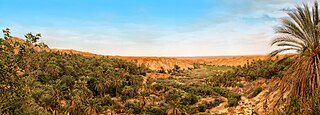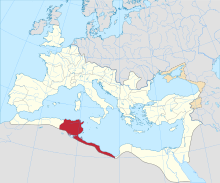Şarkikaraağaç is a town and district of Isparta Province in the Mediterranean region of Anatolia. It is the site of Ancient city and bishopric Hadrianopolis in Pisidia, which remains a Latin Catholic titular see.

Citharizum was a town and fortress on the south arm of the Euphrates in the Roman province of Armenia III.

Negrine is a town and commune in Tébessa Province in north-eastern Algeria. It was the site of ancient Casae Nigrae, a settlement of Roman North Africa with an attached bishopric that remains a Latin Catholic titular see.

Antoine-Augustin Bruzen de La Martinière or de la Martiniere, was a French polymath. His main work was the Grand Dictionnaire Geographique Et Critique published in ten volumes between 1726 and 1739. Thanks to the munificence of his patrons, he lived at the court of Friedrich Wilhelm, Duke of Mecklenburg-Schwerin, then Francesco Farnese, Duke of Parma. He was also employed by king Philip V of Spain.
Choma was a place in the interior of ancient Lycia, according to Pliny on a river Aedesa. Ptolemy places Choma as one of the four cities of the Milyas, and places it near Candyba. The town can be identified with a site near today's village of Hacımusalar in the district of Elmalı.

The Titular Bishopric of Vita (Vitensis) was a Roman–Berber civitas in Africa Proconsularis. It is a former Christian diocese and Latin Catholic titular see. The name 'Vita' means life.

Mutugenna or Muttegena was a colonia (town) of the Roman, Berber and Vandal empires, located in the Maghreb. The city is generally identified with the ruins at Ain-Tebla in modern Algeria. Mutugenna was also the locus of a bishopric and was an important site in the development of the Donatist schism.

Satala or Satala in Lydia was a Roman era city and Bishopric in ancient Lydia.
Acrassus or Akrassos was an ancient Roman and Byzantine-era city in Lydia. in the Roman province of Asia and Lydia. Apparently, it is the same place that Ptolemy calls Nacrasa or Nakrasa, placed on the road from Thyatira to Pergamum.

Tabala, is the name of a Roman and Byzantine town and a Bishopric in ancient Lydia. Tabala was on the Hermus River, and minted its own coins. It is no doubt the same as the one mentioned by Hierocles under the name of Gabala, which is perhaps only miswritten for Tabala. It is even possible that it may be the town of Tabae or Tabai (Τάβαι), which Stephanus of Byzantium assigns to Lydia.
Zattara was an ancient Roman and Byzantine town in the Africa province. It was located in present-day Kef ben-Zioune, south-east of Calama, Algeria. The city was a titular see of the Roman Catholic Church.
Rotaria was an ancient Roman and Byzantine era bishopric of Numidia, North Africa.

Aptuca (Africa) or Henchir Oudeka, also known as Aptucca/Aptuca, Henchir-Oudeka/Henchir-Semmech. or Udeka is a village and archaeological site in Tunisia, North Africa located at 36.409344, 8.940301.

Centenaria was an ancient civitas (town) extant during the Roman Empire. It is tentatively identified as ruins near El Hamel Algeria. The name Centenaria derives from the Centenaria style of fortified farm, around 2000 of which were built along the Limes Africanus in Roman North Africa. Many Centenaria grew to be prosperous and large settlements.
Vagal or Vagalitanus was a Vandal and Roman era civitas (town) in Mauretania Caesariensis, Roman North Africa. The town has been tentatively identified with Sidi ben Thiour on the Mekerra River near its confluence with the Sly River.(36.073819n, 1.094881e) Nearby towns included Castellum Tingitanum and Catabum Castra (Djidioua). The mines at Malakoff were to the north-east of the town.
Vageata, also known as Vageatensis, was a Roman-Berber town in the province of Mauretania Caesariensis. It is also known as Bagatensis, and epigraphical evidence remains attesting to this etymology, due to the interchange of 'v' for 'b' is a common phenomenon in Latin and Greek place names.

Abbir Germaniciana also known as Abir Cella is the name of a Roman and Byzantine-era city in the Roman province of Africa proconsularis. The city was also the seat of a bishopric, in the ecclesiastical province of Carthage, and is best known as the home town of the Pre Nicaean father, Cyprian, who was bishop of Abbir Germaniciana around 250AD.

Pocofeltus was a Roman–Berber civitas (town) in the province of Africa Proconsularis, located in present-day Tunisia. It was also the seat of an ancient Roman Catholic diocese.

The diocese of Tetci is a suppressed and titular see of the Roman Catholic Church. An exact location of the town is now lost to history but it was in today's Tunisia.
The Diocese of Castra Severiana is a suppressed and titular See of the Roman Catholic Church.











